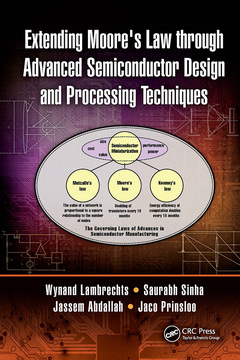Extending Moore's Law through Advanced Semiconductor Design and Processing Techniques
Auteurs : Lambrechts Wynand, Sinha Saurabh, Abdallah Jassem Ahmed, Prinsloo Jaco

This book provides a methodological understanding of the theoretical and technical limitations to the longevity of Moore?s law. The book presents research on factors that have significant impact on the future of Moore?s law and those factors believed to sustain the trend of the last five decades. Research findings show that boundaries of Moore?s law primarily include physical restrictions of scaling electronic components to levels beyond that of ordinary manufacturing principles and approaching the bounds of physics. The research presented in this book provides essential background and knowledge to grasp the following principles:
- Traditional and modern photolithography, the primary limiting factor of Moore?s law
- Innovations in semiconductor manufacturing that makes current generation CMOS processing possible
- Multi-disciplinary technologies that could drive Moore's law forward significantly
- Design principles for microelectronic circuits and components that take advantage of technology miniaturization
- The semiconductor industry economic market trends and technical driving factors
The complexity and cost associated with technology scaling have compelled researchers in the disciplines of engineering and physics to optimize previous generation nodes to improve system-on-chip performance. This is especially relevant to participate in the increased attractiveness of the Internet of Things (IoT). This book additionally provides scholarly and practical examples of principles in microelectronic circuit design and layout to mitigate technology limits of previous generation nodes. Readers are encouraged to intellectually apply the knowledge derived from this book to further research and innovation in prolonging Moore?s law and associated principles.
Chapter 1 The Driving Forces Behind Moore’s Law and Its Impact on Technology Chapter 2 The Economics of Semiconductor Scaling Chapter 3 The Importance of Photolithography for Moore’s Law Chapter 4 Photolithography Enhancements Chapter 5 Future Semiconductor Devices: Exotic Materials, Alternative Architectures and Prospects Chapter 6 Microelectronic Circuit Thermal Constrictions Resulting from Moore’s Law Chapter 7 Microelectronic Circuit Enhancements and Design Methodologies to Facilitate Moore’s Law – Part I Chapter 8 Microelectronic Circuit Enhancements and Design Methodologies to Facilitate Moore’s Law – Part II Chapter 9 The Evolving and Expanding Synergy Between Moore’s Law and the Internet-of-Things Chapter 10 Technology Innovations Driven by Moore’s Law
Johannes Wynand Lambrechts, SMIEEE, obtained his B.Eng., M.Eng., and Ph.D. degrees in Electronic Engineering from the University of Pretoria (UP), South Africa. He achieved his M.Eng. with distinction. He has authored 2 publications in peer-reviewed journals and has presented at various local and international conferences. Wynand is the lead author on two books in the fields on sustainable energy and in microelectronic engineering, published by an international publisher. He has co-authored two contributing chapters in another book in the field of green energy and technology. He previously held a position as an electronic engineer at Denel Dynamics, a state-owned company in South Africa. He is currently employed by SAAB Grintek Defence, and is also serving as a part-time research associate at the University of Johannesburg (UJ), South Africa.
Saurabh Sinha, PhD(Eng), Pr Eng, SMIEEE, FSAIEE, FSAAE, Prof Sinha obtained his B. Eng, M. Eng and Ph.D. degrees in Electronic Engineering from the University of Pretoria (UP). As a published researcher, he has authored or co-authored over 110 publications in peer-reviewed journals and at international conferences. Prof Sinha served UP for over a decade; his last service being as Director of the Carl and Emily Fuchs Institute for Microelectronics, Department of Electrical, Electronic and Computer Engineering. On 1 October 2013, Prof Sinha was appointed as Executive Dean of the Faculty of Engineering and the Built Environment (FEBE) at the University of Johannesburg (UJ). Prof Sinha is currently the UJ Deputy Vice-Chancellor: Research and Internationalisation. Among other leading roles, Prof Saurabh Sinha also served the IEEE as a Board of Director and IEEE Vice-President: Educational Activities.
Jassem Abdallah received his BSc in Chemical Engineering from The University of Texas at Austin with honors (undergraduate research thesis), and both his MSc and PhD in Chemical Engineering from the Georgia
Date de parution : 06-2024
15.6x23.4 cm
Date de parution : 09-2018
15.6x23.4 cm
Thèmes d’Extending Moore's Law through Advanced Semiconductor... :
Mots-clés :
Power Consumption; Internet-of-things (IoT); MOS Transistor; photolithography; Moore’s Law; semiconductor geometric scaling; CMOS Transistor; power-management circuits; MOS Capacitor; fabrication nodes; EUV Lithography; microelectronic circuit design; Technology Node; Lambrechts Wynand; CMOS Inverter; Sinha Saurabh; Optical Interconnects; Abdallah Jassem; Immersion Lithography; Prinsloo Jaco; Threshold Voltage; Wyn Lambrechts; IoT System; Saurabh Sinha; Photonic Crystal Waveguides; Jassem Abdallah; Integrated Resistors; Jaco Prinsloo; IoT Device; Photonic Crystal; Band Gap Voltage Reference; Subthreshold Swing; NAND Flash Memory; Post-layout Simulations; Hot Carrier Injection; IBM Research; Quantum Gate; Equivalent Circuit; Graphene Nanoribbons



